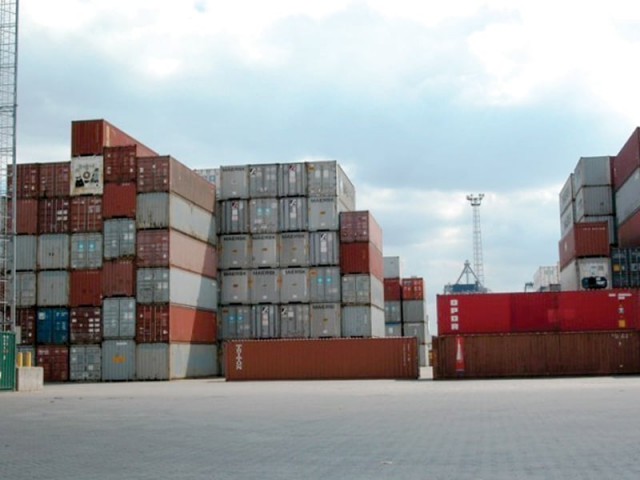Reliance on few markets, products restricting export growth
Pakistan should diversify to avert threat of economic shocks.

This year, Pakistan is expected to fare badly in fruit exports to Dubai and the UK as consignments have been rejected due to infections and substandard goods. PHOTO: FILE
Heavy concentration of exports in few commodities and few markets can lead to instability.
According to World Bank data, Pakistan recorded a trade deficit of Rs213.55 billion in May 2013. The balance of trade showed average deficit of Rs184.082 billion from 1957 to 2013, with the surplus reaching the peak at Rs5.457 billion in June 2003 and the deficit hitting the worst at Rs215.020 billion in December 2011.
Pakistan runs a regular trade deficit primarily because of heavy imports of energy products. Main import goods are fuel (40% of total imports), machinery and transport equipment (18%) and chemicals (16%). Major exports include cotton and knitwear (28% of total exports), bedwear, carpets and rugs (8%) and rice (8%).
This year, the country is expected to fare badly in fruit exports to Dubai and the UK. A consignment of 50 tons of fruit sent to the UK has been rejected on the grounds that it was infected with fruit fly. Until June 21 in fiscal year 2012-13, 28,700 tons of fruit had been exported, but much of this was destroyed because of quality issues.

In the outlook for 2013, continuous weak global growth outlook and heightened uncertainties lead to expectations that world trade will continue to expand at a moderate pace of 4.3% in volume, compared to 3.3% in 2012 and 6.8% from 2005 to 2008.
Recent trade data reflects the spill-over effects on the growth of Pakistan’s exports. Geographically, the EU and the US represent the most important destinations for exports and their markets absorb 31% and 23% of shipments from Pakistan. Therefore, slowdown in US and European economies and weak demand have significantly impacted export growth.
China is the third most important destination for Pakistan with an 11.5% share. Recently, UAE, Afghanistan, Oman and Turkey have also become important destinations.
Despite focusing on a limited number of markets, Pakistan has seen some diversification in exports in the past few years. A few years ago, around 43% of exports were concentrated in five markets (US, UK, Germany, Hong Kong and UAE). This share has been going down continuously and it now stands at 36.3% whereas the share of other countries has increased to 63.7%.
This improvement came mainly on the back of the Strategic Trade Policy Framework (STPF 2009-12) and the resulting increase in exports to China, Afghanistan and Bangladesh.
In 2012-13, the export target was set at $24.8 billion, 4% higher than the previous year. The moderate growth target was set in the wake of energy shortages and slow growth in developed economies.
Exports in the first 10 months (July-April) reached $20.147 billion, up 4.2% from $19.329 billion in the same period of previous year. Of the total, the export of food group rose 12.3%, textile group 6.1% and other manufactures 8.7%.
However, exports are restricted to a small number of items such as cotton and cotton products, leather, rice and few others. Jewellery has recently become another significant export item.
Cotton and cotton products, leather and rice accounted for 63.7% of total exports in the first nine months of 2012-13 with cotton products alone contributing 51.4%.
The share of major export items has come down over the years as they earlier constituted around 70% of total exports. However, compared to the previous year, the share has not improved. Further data assessment shows that most of the export earnings have come from textile manufacturers.
If a country’s exports depend on a narrow range of products, then its export earnings will fluctuate with international price changes and shocks. But the country with a more diversified portfolio will find that fluctuations in prices of some products will not have any significant impact on total earnings.
The lack of diversification in Pakistan’s export markets exacerbates the vulnerability to economic shocks. This leads to volatility and instability in export earnings, which in turn has adverse effects on growth, employment, investment planning, export capacity, foreign exchange reserves, inflation, capital flight and debt payments.
Therefore, Pakistan is required to diversify its export portfolio by adding new products to the export basket. This will enable the country to avoid the risks associated with production and distribution of different products and also reduce reliance on one or few geographical destinations for exports.
For diversification of export markets, Pakistan should develop trade linkages and introduce products in leading markets like Canada, Japan, South Korea and the Netherlands.
The writer is a researcher at the Economic Growth Unit of Sustainable Development Policy Institute
Published in The Express Tribune, July 29th, 2013.
Like Business on Facebook, follow @TribuneBiz on Twitter to stay informed and join in the conversation.



















COMMENTS
Comments are moderated and generally will be posted if they are on-topic and not abusive.
For more information, please see our Comments FAQ